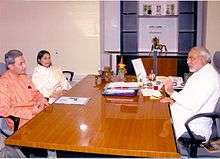Afroz Ahmad
| Dr. Afroz Ahmad | |
|---|---|
 Afroz Ahmad in Germany | |
| Born | Balrampur, Uttar Pradesh |
| Residence | Indore, Balrampur, New Delhi |
| Alma mater |
Dresden University of Technology, Germany United Nations University- Leadership Academy, University of Jordan |
| Occupation | Member(Environment&Rehabilitation)[1] |
| Organization | Narmada Control Authority, Ministry of Water Resources (India) |
| Notable work | Application of Environmental impact assessment in the Himalayas, Major Irrigation projects in Eastern Uttar Pradesh and Human Rehabilitation Displaced Due to major Water Resources Project on the Narmada River.[2] |
| Relatives | Bekal Utsahi father in law |
Afroz Ahmad is an Indian environment scientist and development administrator. He is an advocate for integrating environment and development to ensure sustainable development in India.[3][4]
Before joining Indian service in 1985 he was in United Nations Germany.On 5 December 2014, Ahmad was appointed Member (Environment & Rehabilitation) of the Narmada Control Authority, Ministry of Water Resources (India) Government of India[5] By prime minister of India after the approval of cabinet committee.
Career

In December 2014, Ahmad was appointed Member (Environment & Rehabilitation) in the Narmada Control Authority, Ministry of Water Resources, River Development and Ganga Rejuvenation within the government of India.[6] Before assuming charge as Member, he was Director (Impact Assessment & Rehabilitation) in the Narmada Control Authority.[7]
Ahmad has also worked for the G. B. Pant Institute of Himalayan Environment and Development, Ministry of Environment and Forests (India).[8]
Personal life
Afroz Ahmad married Begum Sadiya Yasmin(Afroz), daughter of poet and Politician Bekal Utsahi. Sadiya is a poetess and social worker.[9]
Publications
Ahmad is author of over 100 research papers, articles and reports on environmental management, sustainable development, policy planning, and human rehabilitation, including three papers published by The Royal Swedish Academy of Sciences. Some notable publications are:
- Assessment of Environmental Impacts of Sarda Sahayak Canal Irrigation Project of Uttar Pradesh Government, India. Int. J.Environmental Studies, ENGLAND, Vol.28, 123-130, 1986.[10]
- Environmental impacts evaluation of Gandak Canal Irrigation Project of Eastern U.P., India and Guidelines for its Management. Int. J. Environmental studies, ENGLAND, Vol.32, pp. 137–149, 1988.[11]
- Analysis of Himalayan Environmental Problems and Guidelines with special emphasis on Application of Environmental Impact Assessment (EIA) for the Planning, Management and for sustainable development. The Environmentalist, ENGLAND,Vol.10, No.4, pp. 281–298, 1990.[12]
- Application of Environmental Impact Assessment in Himalayas: An Ecosystem approach for resources conservation and sustainable development. AMBIO, The Royal Swedish Academy of Sciences (selectors of Nobel Laureates), Stockholm, SWEDEN, Vol.22, No.1, pp. 4–9, February, 1993.[13]
- Environmental Impact Assessment for sustainable development: Chittaurgarh Irrigation Project in Outer Himalayas. AMBIO, The Royal Swedish Academy of Sciences, SWEDEN, Vol.20,No.7, pp. 298–302, November 1991.[14]
- Narmada Water Resources Project, India : Implementing Sustainable Development. AMBIO, The Royal Swedish Academy of Sciences (selectors of Nobel Laureates), Stockholm, SWEDEN, vol. 28 (5) 27, pp. 398–403, August, 1999.[3][4]
- Rehabilitation of the displaced – A comprehensive Policy Approach. The Administrator, Journal of the Lal Bahadur Shastri National Academy of Administrator, Mussoorie, India, Vol.XLIII, pp. 47–64, April–June, 1998.
- Environmental degradation and possible solution for its restoration - A case study of magnesite mining in Indian Central Himalayas. U.N. (UNEP)'s Desertification Control Bulletin, No.21, Nairobi, KENYA, pp. 15–23, 1992.[15]
- Rehabilitation of the displaced – A comprehensive Policy Approach. The Administrator, Journal of the Lal Bahadur Shastri National Academy of Administrator, Mussoorie, India, Vol.XLIII, pp. 47–64, April–June, 1998.[16]
- Problems for the conservation of Fresh Water Fish Genetic Resources in India, and some possible solutions. NAGA, the ICLARM Quarterly, Manila, PHILIPPINES, Vol.18 (4), July, 1995, pp. 21–25.[17]
- Water – A Looming Crisis – In the Book : India’s Development After Independence, Gyan Publishing House, New Delhi, 2002, pp. 263–296.[18]
- Disaster Risk Reduction through Integrated River Basin Management – Policy Approach, NIDM, Ministry of Home Affairs, vol.7, number 1 and 2 December 2013, pp. 181–198.[19]
References
- ↑ http://nca.gov.in/nca%20telephone%20directory.htm
- ↑ Baruah, Rishika (13 June 2014). "Sardar Sarovar Project rehabilitation: Dam...Damned...Duped". India Today. Retrieved 4 September 2018.
- 1 2 Afroz Ahmad. "The Narmada Water Resources Project,India:Implementing Sustainable Development". oriprobe.com. Retrieved 22 October 2015.
- 1 2 Ahmad, Afroz (21 August 1999). "The Narmada Water Resources Project, India: Implementing sustainable development". eurekamag.com. Retrieved 22 October 2015.
- ↑ http://www.nca.gov.in/bio-data/bio-group-a/bio-mem-enr.htm
- ↑ "NARMADA CONTROL AUTHORITY". nca.gov.in. Retrieved 22 October 2015.
- ↑ "India: Action Alert! Act fast to stop planned Uttarakhand in Narmada". sacw.net. Retrieved 22 October 2015.
- ↑ "Perspective Resource Management In Developing Countries: Vol. 3 Ecological ..." google.co.in. Retrieved 22 October 2015.
- ↑ http://www.freepressjournal.in/indore/sur-kavya-raas-leela-today/143587
- ↑ "Assessment of environmental impacts of Sarda Sahayak Canal irrigation project of Uttar Pradesh, government, India". International Journal of Environmental Studies. Tandfonline.com. 28: 123/130. 1986. doi:10.1080/00207238608710316. Retrieved 22 October 2015.
- ↑ "Environmental impacts evaluation of Gandak Canal Irrigation Project of Eastern U.P., India and Guidelines for its Management". International Journal of Environmental Studies. Tandfonline.com. 32: 137/149. 1988. doi:10.1080/00207238808710455. Retrieved 22 October 2015.
- ↑ "The Environmentalist" (PDF). Snowleopardnetwork.org. 1990. ISSN 0251-1088. Retrieved 2015-10-22.
- ↑ "[PDF]Environmental impact assessment in the Himalayas: an ecosystem approach: A. Ahmad, Ambio, 22(1), 1993, pp 4–9-Free Paper Download-FreePaperDownload.us". freepaperdownload.us. Retrieved 22 October 2015.
- ↑ Afroz Ahmad; P. P. Singh Ambio (November 1991). "Environmental Impact Assessment for Sustainable Development: Chittaurgarh Irrigation Project in Outer Himalayas". 20: 298–302. JSTOR 4313849.
- ↑ Ahmad, Afroz. "Biblioteca IDEAM catalog › Details for: Environmental degradation and possible solutions for restoring the land:". Documentacion.ideam.gov.co. Retrieved 2015-10-22.
- ↑ "Item Details". Gipe.ac.in:8080. Retrieved 2015-10-22.
- ↑ Gyan P. Dubey & Afroz Ahmad. "Problems for the Conservation of Freshwater Fish Genetic Resources in India, and Some Possible Solutions" (PDF). Core.ac.uk. Retrieved 2015-10-22.
- ↑ Raj Achal Madhavan. "India's Development After Independence". vedamsbooks.in. Retrieved 22 October 2015.
- ↑ "Disaster & Development" (PDF). Nidm.gov. December 2013. ISSN 0973-6700. Retrieved 2015-10-22.